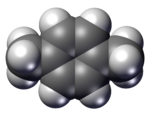p-Xylene
Appearance
| p-Xylene | |

| |
| Names | |
|---|---|
| Other names
p-Xylol
1,4-Dimethylbenzene | |
| Identifiers | |
3D model (JSmol)
|
|
| ECHA InfoCard | 100.003.088 |
| RTECS number |
|
CompTox Dashboard (EPA)
|
|
| |
| Properties | |
| C8H10 | |
| Molar mass | 106.16 g/mol |
| Appearance | Colorless liquid colorless crystalline solid |
| Density | 0.861 g/mL |
| Melting point | 13.2 °C (55.8 °F; 286.3 K) |
| Boiling point | 138.35 °C (281.03 °F; 411.50 K) |
| insoluble | |
| Solubility in ethanol | very soluble |
| Solubility in diethyl ether | very soluble |
Refractive index (nD)
|
1.49582 |
| Viscosity | 0.7385 cP at 0 °C 0.6475 cP at 20 °C |
| 0.07 D | |
| Hazards | |
| Occupational safety and health (OHS/OSH): | |
Main hazards
|
Harmful or fatal if swallowed. Vapor harmful. Flammable liquid and vapor. |
| NFPA 704 (fire diamond) | |
| Flash point | 25 °C |
| Related compounds | |
| Supplementary data page | |
| P-Xylene (data page) | |
Except where otherwise noted, data are given for materials in their standard state (at 25 °C [77 °F], 100 kPa).
| |
p-Xylene is an aromatic hydrocarbon, based on benzene with two methyl substituents. The “p” stands for para, identifying the location of the methyl groups as across from one another.
It is an isomer of xylene. Other isomers include o-xylene and m-xylene. p-Xylene is used on a large scale for the manufacture of terephthalic acid for polyester. Its polymer is known as Parylene. p-Xylene is produced by catalytic reforming and separated in a series of distillation and reaction processes from m-xylene, o-xylene and ethylbenzene. Its melting point is the highest among this series of isomers, but simple crystallization does not allow easy purification due to the formation of eutectic mixtures.
References
External links

